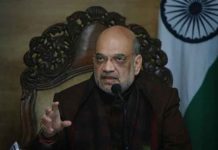
A dozen women are sitting around a lavish living room in Chandigarh, full of bubbling chatter and cocktail flutes. A gripping game called ‘Never Have I Ever’ is in full swing. Nina (name changed) raises her glass and declares, “Never have I ever had an abortion!” The room suddenly falls silent and everybody, except Nina, takes a sip from their respective glasses. It is a kitty party. Most of the women are married. The conversation invariably veers towards recurrent abortions in married and divorced women. Nina whispers that Shehnaz (name changed) tops the list as “she keeps having these abortions now and then.”
Shehnaz is a 36-year-old married woman with two young kids. She sighs,“I had both my kids within the first three years of my marriage. We did not want any more kids but my husband does not like condoms. The third time I got pregnant, I visited a local gynaecologist who prescribed me an abortion kit called Unwanted. After that, whenever I get pregnant, I just go to a chemist and buy the same kit, using the old prescription. It’s easier and no-one gets to know. I don’t want to create discord in the house by haggling over such trivial issues.” Shehnaz has not kept count of the number of abortions she has had. This is a sad reality in India, where abortion is used as the go-to method to space out children or even as a casual alternative to generic contraception.
Despite a ban on the sale of over the counter medical abortion (MA) pills without prescription, they are easily available due to lack of proper verification by small chemist shops and ease of distribution from unlicensed sources. According to a study published in the Lancet, MA pills accounted for over 80 per cent of all abortions in 2015. These pills, though safe for terminating early pregnancies under proper medical guidance, can be considered illegal and unsafe. Impetuous and recurrent usage of MA pills can lead to incomplete abortions, infections as well as future infertility. More than 75 per cent of the 15.6 million abortions estimated to occur in India annually are done outside of health facilities and half of them are unsafe. Around 5-7 per cent abortions done outside licensed facilities use other methods that are possibly dangerous. They result in 9 per cent of all maternal deaths in India. The actual figure may be higher as noninstitutionalised abortions cannot be recorded. The situation is even worse for single/divorced women and those in rural regions.
India was one of earliest countries to legalise abortion. The Medical Termination of Pregnancy Act, 1971, legalised abortions up to 20 weeks but the law left the onus on the opinion of licensed medical practitioners. Sadly, they can be judgmental as a part of a skewed society. Moreover, the MTP Act fails to define terms like ‘abortion’, ‘miscarriage’, ‘termination of pregnancy’, ‘medical & surgical abortion’, ‘health’, ‘substantial risk’, etc. In India, where female sexuality is controlled, stigmatised and exists supplementary to male sexuality, a woman bears the burden of explaining how carrying a pregnancy to term may harm her physical/mental health. So a woman cannot simply demand an abortion. Such a law does not affirm a woman’s reproductive rights.
During the last four decades, despite technological advancements and ease of abortion procedures, the law has remained the same. Stakeholders have struggled to take the common man in to the fold and operationalise the act in a way that provides women to control over their own reproductive choices and rights. Religious, social and cultural issues, in addition to rampant misconceptions, restrict the use of contraception. Out of an annual estimate of 48.1 million pregnancies, half are unintended and a third of them result in abortions. Only obstetricians and gynaecologists, just over 34,000 nationally, can provide abortions. Thus the number of approved abortion providers in India is too low compared to the number of women in need. Moreover, these practitioners are mostly concentrated in urban areas. So women are compelled to approach illegal, unqualified providers, thereby endangering their lives and health.
According to Dr Shefali Wadhwani Sharma, a gynaecologist at GMCH, Chandigarh, ”Low acceptability of explicit contraception means that illegal abortions are still rampant in rural India. Women with unwanted pregnancies, in rural and semi-urban areas, are often hesitant to go to doctors due to family pressure and privacy issues. Midwives, quacks and unqualified RMPs use unsafe methods to induce abortions such as insertion of sticks and roots, ingestion of herbal medicines, abortifacient drugs, abdominal massage and incomplete D&Cs in unhygienic conditions. It can lead to sepsis/ infection, which if left untreated may even cause death. Other side effects are internal haemorrhage, injuries to vital organs and future infertility. We often get critical cases with ruptured uteri due to abortions gone bad but some of these unmarried young girls still refuse to admit that they have been sexually active.”
The patriarchal mindset results in preference of the male child. Despite crackdowns on potential offenders, quacks and midwives often use unreliable methods to predict the sex of an unborn child, thus leading to unsafe abortions in case of unfavourable news. Indian women, who often lack financial freedom and/or authority in a household, rarely have the right to choose their own reproductive future. In a society where talking about sex is a big taboo and child-bearing is considered a woman’s responsibility, most men are reluctant to get involved in maternal health and reproductive issues of their partners. Women are discouraged from using temporary contraception by their own peers. Male contraception is rarely used and even more inconsistent in steady relationships. The condom usage in India is a dismal 5 per cent. As Nina puts it, “ Men only use condoms when they have a fear of getting a disease like AIDS. Why would they use it with their wives or girlfriends?”
Over the last decade, Indian courts have issued several notable judgements recognising women’s reproductive rights as a part of the ‘inalienable survival rights’, implicitly protected under the fundamental right to life. Some of these landmark judgements recognise these rights as essential for equality of women and urged them to have greater autonomy and powers of decision making concerning their pregnancies. In 2014, some much-needed amendments were proposed for the MTP Act. Alas! they were sent back for revision and are still stuck under the proverbial red tape. Laws to prevent pre-natal sex selection (PCPNDT Act) and sexual offences against minors (POSCO Act) have outdated clauses that often lead to confusion, interference and harassment of genuine medical and pharmaceutical practitioners, who are becoming increasingly reluctant to provide abortion services.
The lack of awareness and sensitisation amongst Indian women regarding their reproductive rights, social stigma, complicated and outdated laws, governmental ignorance and shortage of licensed abortion providers have led to illegal and unsafe abortion methods threatening to become a pandemic that can easily be prevented. As we join hands with the world to demand amendments in Irish abortion laws after the tragic death of Dr Savita Halappanavar, maybe it is time to look inwards at our own abortion laws. We need to introspect as a society whether we are ready to give our women true equality by recognising their absolute right to reproductive choice and hence their own bodies.
letters@tehelka.com












